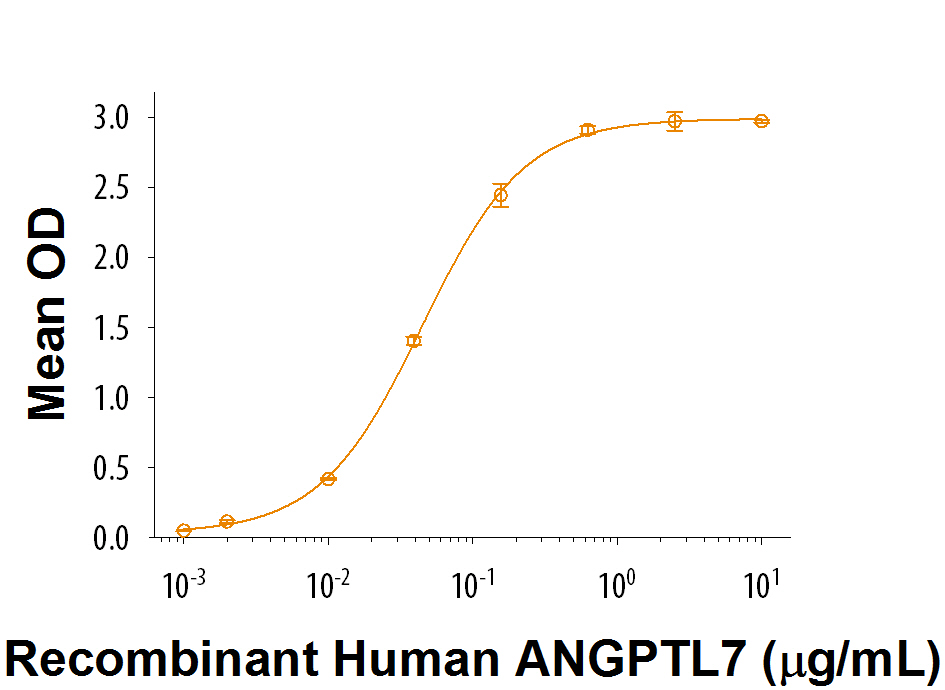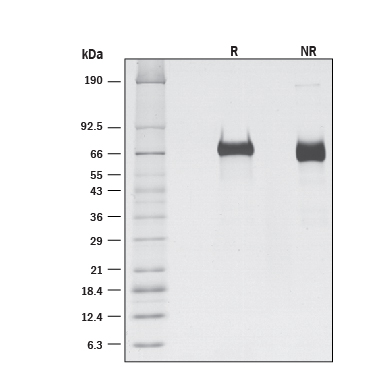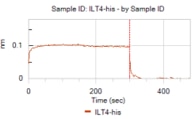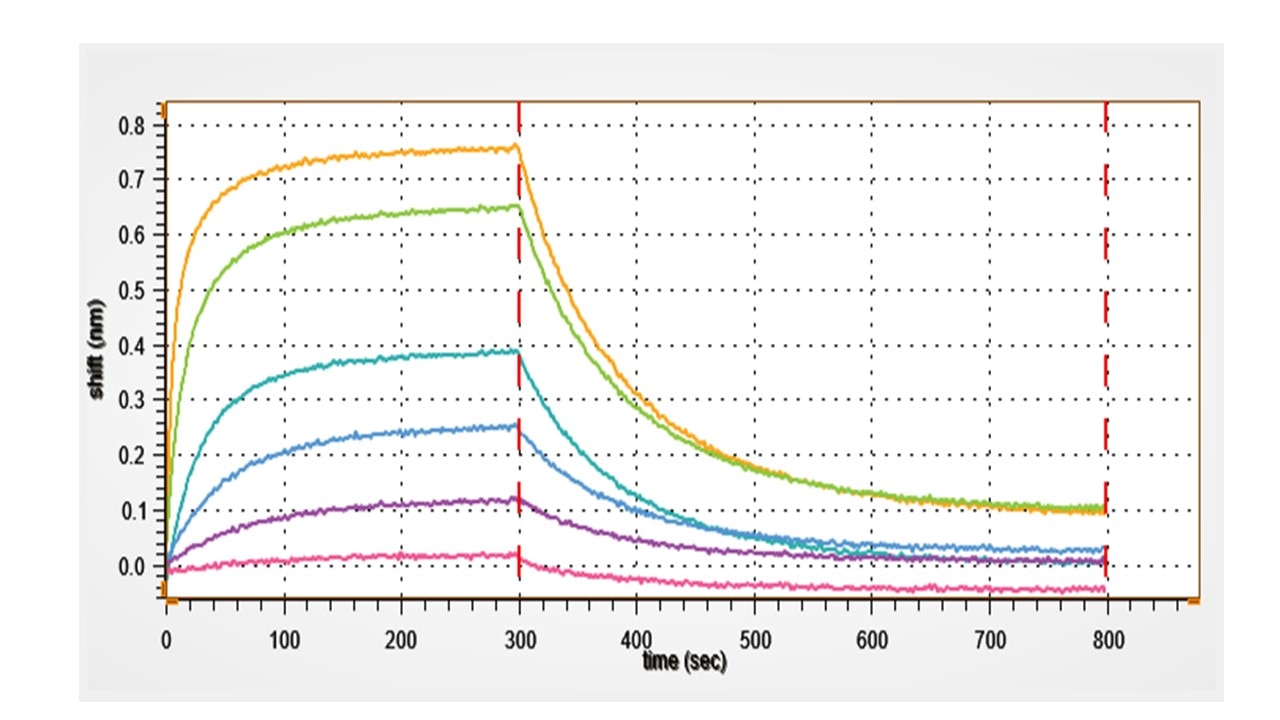Recombinant Human LILRB2/CD85d/ILT4 His-tag Protein, CF
Recombinant Human LILRB2/CD85d/ILT4 His-tag Protein, CF Summary
Product Specifications
Gln22-His458, with a C-terminal 6-His tag
Analysis
Product Datasheets
Carrier Free
CF stands for Carrier Free (CF). We typically add Bovine Serum Albumin (BSA) as a carrier protein to our recombinant proteins. Adding a carrier protein enhances protein stability, increases shelf-life, and allows the recombinant protein to be stored at a more dilute concentration. The carrier free version does not contain BSA.
In general, we advise purchasing the recombinant protein with BSA for use in cell or tissue culture, or as an ELISA standard. In contrast, the carrier free protein is recommended for applications, in which the presence of BSA could interfere.
8429-T4
| Formulation | Lyophilized from a 0.2 μm filtered solution in PBS. |
| Reconstitution | Reconstitute at 100 μg/mL in PBS. |
| Shipping | The product is shipped at ambient temperature. Upon receipt, store it immediately at the temperature recommended below. |
| Stability & Storage: | Use a manual defrost freezer and avoid repeated freeze-thaw cycles.
|
Scientific Data
 View Larger
View Larger
When Recombinant Human LILRB2/CD85d/ILT4 (Catalog # 8429-T4) is coated onto a microplate at 2 µg/mL, Recombinant Human Angiopoietin-like 7 Protein (Catalog # 914-AN) binds with a typical ED50 of 25-150 ng/mL.
 View Larger
View Larger
1 μg/lane of Recombinant Human LILRB2/CD85d/ILT4 (Catalog # 8429-T4) was resolved with SDS-PAGE under reducing (R) and non-reducing (NR) conditions and visualized by silver staining, showing bands at 69.9 and 66.8 kDa, respectively.
Reconstitution Calculator
Background: LILRB2/CD85d/ILT4
The immunoglobulin-like transcript (ILT) molecules comprise a family of activating and inhibitory type immunoreceptors whose genes are located in the same locus that encodes killer cell Ig-like receptors (KIR) (1, 2). ILT4, also known as CD85d, LIR-2, and LILRB2, is closely related to mouse PIR-B and is primarily expressed on monocytes, dendritic cells (DC), and neutrophils (3, 4). Mature human ILT4 consists of a 440 amino acid (aa) extracellular domain (ECD) with 4 Ig-like domains, a 21 aa transmembrane segment, and a 116 aa cytoplasmic domain with 3 inhibitory immunoreceptor tyrosine-based inhibitory motifs (ITIMs) (5). The ECD of human ILT4 shares 76% aa identity with chimpanzee ILT4 and 74%, 81%, 33%, 52%, 77%, 61%, and 64% aa identity with human ILT1, 2, 3, 5, 6, 7, and 8, respectively. ILT4 binds to classical MHC I proteins as well as the non-classical HLA-G1 and HLA-F molecules (5-9). It competes with CD8 alpha for MHC I binding but does not compete with KIR2DL1 (7). Ligation of ILT4 induces tyrosine phosphorylation within its cytoplasmic ITIMs, association with SHP-1, and inhibition of stimulatory signaling (3, 6). ILT4 activation promotes the development of tolerogenic dendritic cells and the subsequent induction of regulatory T cells and CD4+ T cell anergy (10-12). Ligation of ILT4 on neutrophils further attenuates immune responses by inhibiting neutrophil phagocytic activity and production of reactive oxygen species (4). ILT4 also binds to multimeric Angiopoietin-like 2, and its ligation supports the expansion of hematopoietic stem cells from cord blood (13). In the brain, ILT4 and mouse PIR-B function as receptors for oligomeric Abeta (1-42) peptide (14).
- Suciu-Foca, N. et al. (2005) Int. Immunopharmacol. 5:7.
- Hofmeister, V. and E.H. Weiss (2003) Semin. Canc. Biol. 13:317.
- Fanger, N.A. et al. (1998) Eur. J. Immunol. 28:3423.
- Baudhuin, J. et al. (2013) Proc. Natl. Acad. Sci. USA 110:17957.
- Borges, L. et al. (1997) J. Immunol. 159:5192.
- Colonna, M. et al. (1998) J. Immunol. 160:3096.
- Shiroishi, M. et al. (2003) Proc. Natl. Acad. Sci. USA 100:8856.
- Lepin, E.J.M. et al. (2000) Eur. J. Immunol. 30:3552.
- Allen, R.L. et al. (2001) J. Immunol. 167:5543.
- Chang, C.C. et al. (2002) Nat. Immunol. 3:237.
- Ristich, V. et al. (2005) Eur. J. Immunol. 35:1133.
- Gregori, S. et al. (2010) Blood 116:935.
- Deng, M. et al. (2014) Blood 124:924.
- Kim, T. et al. (2013) Science 341:1399.
FAQs
No product specific FAQs exist for this product, however you may
View all Proteins and Enzyme FAQsReviews for Recombinant Human LILRB2/CD85d/ILT4 His-tag Protein, CF
Average Rating: 4.5 (Based on 2 Reviews)
Have you used Recombinant Human LILRB2/CD85d/ILT4 His-tag Protein, CF?
Submit a review and receive an Amazon gift card.
$25/€18/£15/$25CAN/¥75 Yuan/¥2500 Yen for a review with an image
$10/€7/£6/$10 CAD/¥70 Yuan/¥1110 Yen for a review without an image
Filter by:
Reason for Rating: HLA-G reagent shows specific binding to ILT4. Binding is weak so could not get KD
Immobilize HLA-G and flow ILT4. Reverse orientation also shows binding


